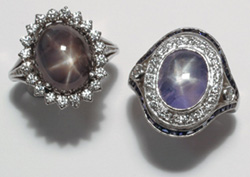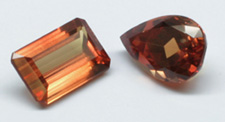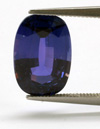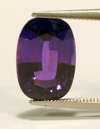Sapphire—Gem Superstar
Last year a 22.66 carat Kashmir sapphire sold at Christie's for a world record price of $3,064,000. That's $135,000 per carat! One expert said the occasion marked the ascension of Kashmir sapphires into the pantheon of superstar gemstones.
Star sapphire is one of the most |
High esteem for sapphire isn't new. The ancient Persians believed that the earth rested on a giant sapphire and its reflection colored the sky. The British Crown Jewels are full of large blue sapphires, emblematic of pure and wise rulers.
A humble combination of aluminum and oxygen make up the gem species corundum, and traces of other minerals impart an almost infinite range of colors. When the color of the corundum is red, jewelers call the gem Ruby; any other color they call Sapphire. Though we usually think of sapphires as blue, they also come in greens, yellows, pinks, purples, and even white (colorless).
These striking gems |
Location, Location, Location
Sapphires are mined in countries as far apart as Colombia, Australia, Nigeria, and the U.S. In some cases, provenance has a crucial effect on the gem's value.
Stones from Kashmir, Burma, and Sri Lanka (Ceylon) fetch some of the highest prices because of their superior clarity, hue and saturation. Kashmir was heavily mined during a brief period in the late 1800's, after an earthquake-induced landslide revealed the sapphire find. The region was soon fully depleted and is no longer a major source of sapphire, but non-heated sapphires from Kashmir still command the highest prices. Today Kashmir sapphires are mostly found in high-end retail and resale markets, such as at auctions.
Some sapphires have the |
Inclusions of foreign material help gemologists determine the gem's origin. Gemologists describe the inclusions in sapphire with terms such as crystals, needles, halos, silk, and fingerprints. Silk, fine fibers of other minerals that have the look of silk, is a preferred inclusion because it signals that the sapphire is natural and has not undergone heat treatment.
Note: You can verify a sapphire's origin through the labs at American Gem Trade Association (AGTA).
Note: Provenance alone does not determine a sapphire's value. Be sure to get an appraisal that details the quality of the gem.
Treatments
Sapphires are usually heat-treated to enhance the gem's color and clarity. Heating should be mentioned on the appraisal, but even if no mention is made, it is assumed sapphire has been heat-treated unless otherwise specified. This treatment is permanent and will not degrade over time.
- Note: A sapphire that is not heat treated is extremely rare, and lack of the treatment should be specifically stated on the appraisal. Unheated natural sapphires may sell for 4 to 5 times the price of a heat-treated sapphire of similar appearance.
Note: Other treatments, such as fracture filling, oiling, dyeing or waxing, are not considered permanent and they lower the value of the gem. They should be mentioned on the appraisal.
Synthetics
Corundum (sapphire or ruby) was the first gemstone to be produced by artificial means, using the Verneuil Process invented in 1902. This process has been replaced by newer technologies, and synthetic gem-quality blue sapphire is now widely available.
A gemologist can detect the difference between natural and synthetic sapphire by observing the growth lines and the characteristic inclusions. Synthetic, or lab-grown, sapphire should be so described on the appraisal.
Note: Not every jeweler is competent to appraise and value colored stones. A retailer without the appropriate gemological training or gem lab may not even recognize synthetic sapphire or the color or clarity enhancements.
Scam: The Great Beryllium Bake Sale
Sapphire owes its many colors to trace elements in the corundum which cause color or modify the strength of a color. Researchers found that heating corundum along with beryllium also affects color, in effect adding another trace element.
In 2001 the gem market was flooded with padparadscha look-alike sapphires created by the use of beryllium diffusion. Padparadscha is a rare and very valuable sapphire with delicate orange-to-pink coloring. It is mined in Sri Lanka and takes its name from the local word for the lotus flower. Dealers were taken in by the beryllium-treated stones, and much of the bogus padparadscha no doubt made its way into the marketplace.
Note: Natural padparadscha sapphire is extremely rare and very valuable. Insist on a grading report from a reliable lab (such as AGTA) to be sure padparadscha is not color-treated.
Gem treaters continue to use beryllium to produce orange-pink, golden yellow and even blue sapphires. Color treatment is an easy way to pump up the price of low-quality corundum. Those doing the sapphire treatment know that for dealers—not to mention consumers—the cost of testing smaller stones for evidence of beryllium is so great as to be prohibitive.
In retail sales, most of these treated sapphires are not being disclosed for what they are. Jewelry Television, for example, uses the term "bulk diffusion", which hardly explains anything to a lay person. As John Emmett of Crystal Chemistry puts it, "Diffusion is a form of dyeing plain and simple."
Note: Beryllium-diffused sapphire (natural or synthetic) is less valuable that untreated sapphire of similar appearance. Be sure the appraiser has the training, experience and gem lab needed to identify sapphire treatments.
Scam: Thai Turn-a-Profit Sapphires
One of the most pervasive and long-lived gem scams is aimed at visitors to Thailand. Typically, a tourist is told by his driver that the attraction he wants to visit is temporarily closed and offers to take him to a "government shop" where he can buy blue sapphires to sell back home for twice as much. The seller may well offer a full refund if the buyer isn't satisfied, and may even put an official-looking stamp on the receipt.
However: the sapphires turn out to be overpriced stones of poor quality. And: the buyer cannot get a refund. Often the shop has gone out of business, though the owner may continue doing the same kind of transactions in the same location under a different business name. This scam has been going on for years.
Note: Vacationers are an easy mark for gem scams. Be wary of insuring gems or jewelry bought on holiday in tourist areas. Insist on detailed and reliable JISO 78/79 appraisals.
FOR AGENTS & UNDERWRITERS
High-value Kashmir, Burma and Ceylon rubies and sapphires should be accompanied by a report from a reliable lab (such as AGTA, AGL or Gübelin) verifying origin. (The insured can take the jewelry to his own jeweler, who will send it to a lab that has the equipment and expertise to determine gem origin.)
For sapphires and other colored stones, color is the main determinant of value. The appraisal should describe the gem's color in terms of tone, saturation and hue. A vague description, such as "blue sapphire," is useless.
Synthetic sapphires are quite common. The appraisal should state that the gem is either natural or synthetic, since synthetic gems are worth considerably less than natural.
For sapphires, it is essential that the appraisal be written by a gemologist experienced with colored stones and familiar with the current pricing, treatments and frauds. Most jewelers deal primarily with diamonds, and even a trained gemologist may have little experience with colored stones.
For sapphire, all treatments other than heating should be disclosed on the appraisal. (Heat treatment may also be listed, but sapphire is assumed to be heat-treated unless the appraisal specifies it has not been.) A trained gemologist will be able to identify treatments that should be disclosed.
If a gem is not treated, that should be specifically stated on the appraisal. A treated stone has only a fraction of the value of an untreated gem of similar appearance.
A reminder: As discussed in the May 2002 issue, the reliability of a colored stone certificate depends on the lab that issues it. If you are insuring a sapphire accompanied by a certificate, it would be worthwhile to review the May 2002 issue. In any case, a certificate is not a substitute for an appraisal. Certificates describe only the gem, not the jewelry, and they do not give valuation.
FOR ADJUSTERS
Synthetic sapphires are worth much less than natural. Check the appraisal for words such as synthetic, lab-grown, cultured or manufactured. The term "Lindy" or "Linde" describes a star sapphire that is synthetic.
Always have damaged stones examined by a gemologist (who is not the selling jeweler) before settling a claim. For sapphires (and all colored gems), be sure to consult a jeweler who regularly deals with colored gemstones. The jeweler should be a graduate gemologist and preferably also a Certified Insurance Appraiser™.
While there are fewer claims on colored stones than on diamonds, colored stones usually have much higher markups and generally have inflated valuations. A typical one-carat sapphire, for example, has a replacement cost of $200-$300.
Since beryllium-diffused sapphires have permeated the marketplace, look for mention of this treatment (sometimes called "bulk diffusion") on the appraisal. Do not assume that if the appraisal doesn't mention treatments, the gem must be untreated; most likely, if treatment (or lack of it) is not mentioned, other information is incomplete as well.
For claims on damaged stones, always have high-priced jewelry inspected by a reliable appraiser to determine whether the gems have been treated. Treatments such as fracture filling may break down, causing changes in the stone that are not damage for which the insurer is liable.
©2000-2024, JCRS Inland Marine Solutions, Inc. All Rights Reserved. www.jcrs.com





